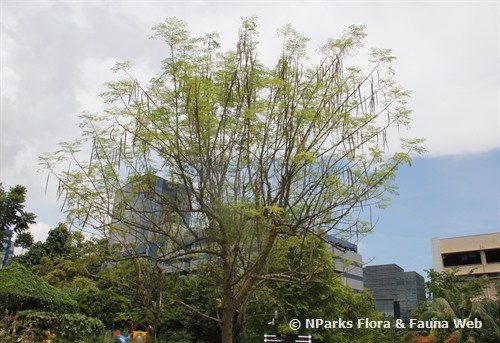
Back
Moringa oleifera Lamk
| Family Name: | Moringaceae |
| Synonyms: | Moringa pterygosperma |
| Common Name: | Horse-radish Tree, Kelur, Merunggai, Drumstick Tree, 辣木 |
Name
Classifications and Characteristics
| Plant Division | Angiosperms (Flowering Seed Plants) (Dicotyledon) |
|---|---|
| Plant Growth Form | Tree (Small (6m-15m)) |
| Lifespan (in Singapore) | Perennial |
| Mode of Nutrition | Autotrophic |
| Plant Shape | Umbrella, Weeping / Pendulous, Open |
| Maximum Height | 10 m |
| Tree or Palm – Trunk Diameter | 0 |
Biogeography
| Native Distribution | India |
|---|---|
| Native Habitat | Terrestrial |
| Preferred Climate Zone | Tropical, Sub-Tropical / Monsoonal |
| Local Conservation Status | Non-native (Horticultural / Cultivated Only) |
Description and Ethnobotany
| Growth Form | A fast-growing, much-branched and crooked tree with a corky bark. Although deciduous, tree seldom shed all its leaves. Possesses tuberous roots. When injured, the plant exudes a milky sap. |
|---|---|
| Foliage | Young shoots are purplish or greenish white. Leaves are green and 2 to 3 pinnate, with up to 6 pairs of pinnae. Leaflets are obovate in shape. |
| Flowers | Flowers are borne on an erect or spreading panicle comprising of numerous white, fragrant flowers. |
| Fruit | Fruit is a three-angled, long and slender capsule. Green when young, the fruits turn brown when mature. |
| Associated Fauna | Flowers are pollinated by insects, such as bees. |
| Cultivation | It prefers to be grown under full sun, in well-drained and fertile soil. Plant is drought-tolerant and takes pruning very well which is necessary to promote regrowth and keep its shape in check. Propagated via seeds and stem-cuttings. Can be planted as a hedge for the provision of wind protection, shade and support for climbing garden plants. |
| Etymology | The genus Moringa is from a Malabar vernacular name, moringo, for the horse-radish tree. The specific epithet oleifera means oil-bearing |
| Ethnobotanical Uses | Edible Plant Parts : Edible Fruits, Edible Leaves, Edible Flowers, Edible Seeds Food (Fruit or Vegetable): Immature green pods, called “drumsticks” are edible and often used in curries. They are eaten by sucking out their internal contents and the tough valves are discarded. Seeds inside mature pods can be eaten like peas or roasted like nuts. Flowers are also edible when cooked. Roots are shredded and used as a condiment like horseradish. The highly nutritious leaves are cooked and used like spinach and can also be dried and crushed into a powder that is used in soups and sauces. (Herb or Spice) Medicinal: Leaves and root bark have numerous folk medicinal uses. Others: Mature seeds contain about 25% oil that does not turn rancid. Used for cooking, lubrication and perfumery purposes. Seed are also pounded and used to purify dirty or cloudy drinking water. |
Landscaping Features
| Thematic Landscaping | Economic Garden |
|---|
Fauna, Pollination and Dispersal
| Pollination Method(s) | Biotic (Fauna) (Insects (Bee)) |
|---|
Plant Care and Propagation
| Light Preference | Full Sun |
|---|---|
| Water Preference | Moderate Water |
| Plant Growth Rate | Moderate |
| Rootzone Tolerance | Fertile Loamy Soils, Well-Drained Soils |
| Maintenance Requirements | Low |
| Propagation Method | Seed, Stem Cutting |
Foliar
| Foliage Retention | Deciduous |
|---|---|
| Mature Foliage Colour(s) | Green |
| Mature Foliage Texture(s) | Smooth |
| Prominent Young Flush Colour(s) | Green |
| Young Flush Texture(s) | Smooth |
| Foliar Type | Compound (Bipinnate) |
| Foliar Shape(s) | Non-Palm Foliage (Ovate, Obovate) |
| Foliar Margin | Entire |
| Foliar Apex - Tip | Rounded |
| Leaf Area Index (LAI) for Green Plot Ratio | 2.5 (Tree - Open Canopy) |
Non - Foliar and Storage
| Trunk Type (Non Palm) | Woody |
|---|---|
| Specialised Storage Organ(s) | Underground (Root Tuber) |
Floral (Angiosperm)
| Flower & Plant Sexuality | Bisexual Flowers |
| Flower Colour(s) | White |
|---|---|
| Flower Texture(s) | Smooth |
| Flower Grouping | Cluster / Inflorescence |
| Flower Symmetry | Bilateral |
| Inflorescence Type | Panicle |
| Flowering Period | Free-Flowering |
Image Repository
Others
| Master ID | 1741 |
|---|---|
| Species ID | 3034 |
| Flora Disclaimer | The information in this website has been compiled from reliable sources, such as reference works on medicinal plants. It is not a substitute for medical advice or treatment and NParks does not purport to provide any medical advice. Readers should always consult his/her physician before using or consuming a plant for medicinal purposes. |







